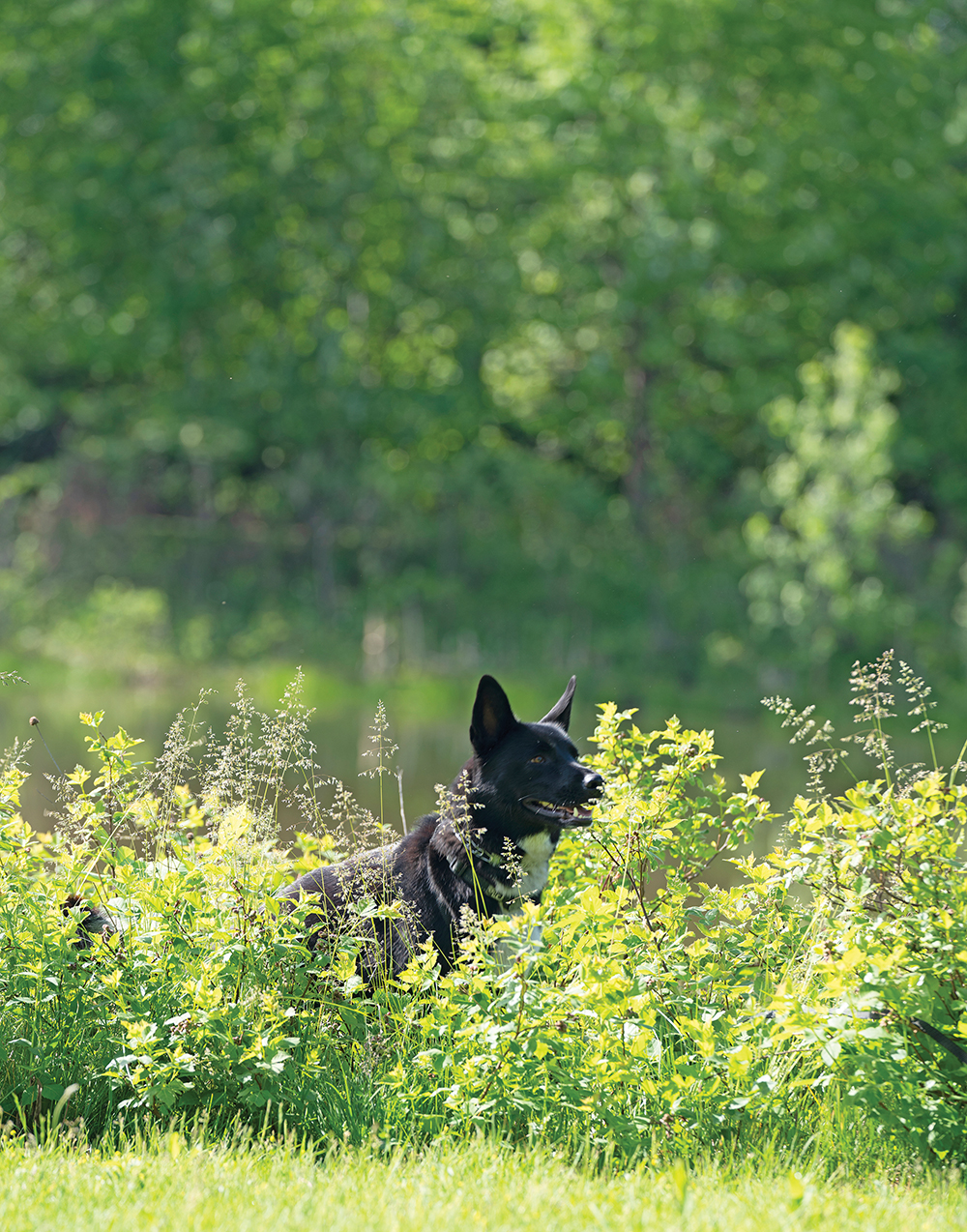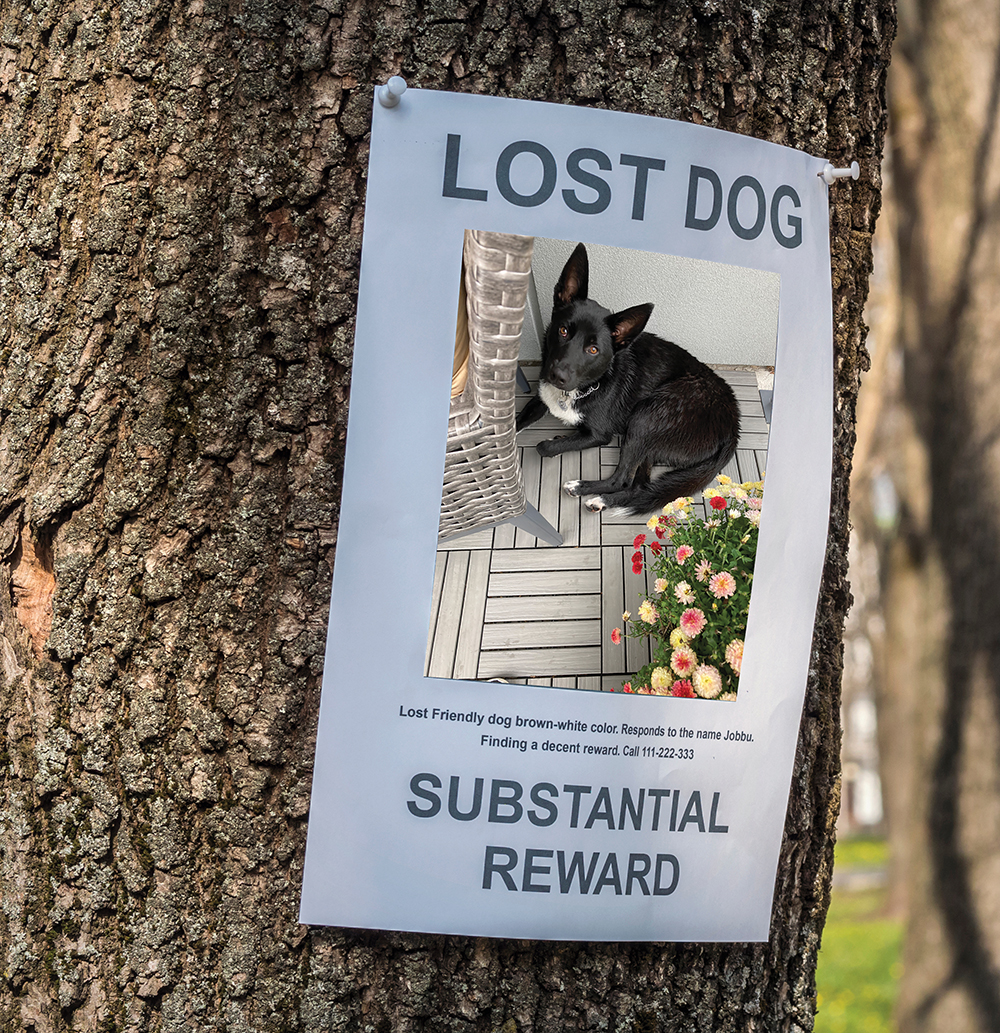Perfect dog owners can train their pets not to bolt. For the rest of us, there are microchips and GPS tracking.
by Dianne Rinehart // Photography by Kaiden Collver


We circle the block about 10 times until I’m desperate, sure she has been hit by a car or gone home with someone else, because she is so sweet and friendly.
Oh boy. This is a dilemma.
I finally have my sweet Husky mix, Daisy, who bolted to chase rabbits, cornered. But where she is sniffing and snooping is a bit of a problem. She is on a stranger’s front porch.
I am praying, as I approach stealthily, that I can nab her before anyone sees me. This will be a bit challenging, though, because the homeowner’s living room windows face directly onto the porch.
“Please, please don’t let anyone be sitting in their living room naked,” I plead. Or, worse: “Please don’t let the inhabitants of this home be having sex on their living room floor!”
I avert my eyes, just in case, as I slowly and softly approach. “Want a liver treat?” She does. I put her leash on, and gently tug her away from the home.
This is not—shame on me—the first time Daisy has escaped. She once bolted, while still on her leash, during what was supposed to be a pee break at a friend’s dinner party.
You may have heard us calling her loudly and persistently at around midnight as we tramped through deep snow from property to property in your lovely housing estate that backs onto a golf course. Thank you for not calling the police.
But eerily, there was no replying bark or whine from Daisy.
I worried she’d been eaten by coyotes.
But thankfully, no. Instead, she was standing silently only feet away from where she had started out, leash caught in a bush. The only reason we finally saw her is because her white chest stood out from her invisible-in-the-dark, black fur.
Only a few days after that episode, it’s a perfect ski day when Daisy decides to duck out under the garage door just as I am shutting it to ensure, ahem, that she won’t be able to run away when I take her leash off.
By the time I get outside she has disappeared across the street, leaving my friend and me to spend an hour of precious, sunny ski time searching for her, first on foot into people’s yards, then by car.
We circle the block about 10 times until I’m desperate, sure she has been hit by a car or gone home with someone else, because she is so sweet and friendly. Then there she is, prancing happily back towards my friend’s house from which she’d been so determined to escape.
I’m so excited to see her that I leap out of the car—probably while it’s still moving—and call to her with a treat. My dear dog is finally back in hand. After that episode, Daisy may not have learned, but I did.
I researched GPS tags for dogs and settled on an Apple AirTag.
It is a small, round disc that can be attached with fasteners to luggage. You get a phone alert if you leave your suitcase behind.
But it can also, as techno wizards have pointed out, be attached to dog collars—and is water resistant, to boot, for swimmers like Daisy.
It costs $40, but soon proves its worth when Daisy gets loose again.
I pull out my cell phone and check Find My Phone. The tag for Daisy is listed there. I click on it, and a map appears showing Daisy’s exact location, complete with an address.
What? It’s showing the address where I already am. Useless technology, I think, because I have already circled the house. But then I hear my friend calling. He has her. She was at the side of the house, and Apple was spot on while I was not.
How does it work?
“The AirTag uses both Bluetooth and a more precise positioning technology called ultrawideband (UWB) to pinpoint the tracker’s location,” says the New York Times. “Like a souped-up version of Bluetooth, UWB will point you in your AirTag’s direction with compass-like accuracy if you’re using an iPhone close to the missing AirTag. If you’re farther away, Apple’s Find My app network and Bluetooth from other iPhone users can help you find it instead.”
Still, there are limits to what an AirTag GPS tracker can do, and if your dog is a chewer, you may not want to put anything on his collar that he can somehow get at and swallow, says Dr. Jennifer Dodd of the Mountain Vista Veterinary Hospital.
There are larger, more durable GPS systems that are designed specifically to track dogs, she notes.
Still, whatever the limitations of any GPS tracker you choose, I am predicting they will be bestsellers down the road, if they aren’t already.
Why? Let’s just say they’re preferable to replacing your neighbour’s chickens, buying a new pool cover, breaching international border security, or losing your beloved pet entirely.
My friend Nancy Wood’s beagle mix Whisky is a true escape artist.
“What we did not consider when naming him after a kind of alcohol is how stupid we would feel running around the neighbourhood yelling: ‘Whisky! Whisky!’,” she says.
“The last time he escaped it was to visit a neighbour’s chicken coop. Luckily, he had a long lead on him, so we found him with that lead wrapped around the coop and the chickens safe inside.
“The time before that, he chased a cat toward an inground swimming pool. The cat was smart enough to swerve at the last minute, but Whisky went right in. Problem: the pool had its cover on. He shredded it. The pool owner saw what was happening and jumped in to save him. Let’s just say, she was cold and wet and not pleased and we had to buy a new pool cover.
“He has also escaped at the cottage, right near the U.S. border, which is patrolled by the RCMP and Canadian Border Services Agency with helicopters and SUVs. We got him back before he crossed!”
Then there is Paul Williams, who shared the saga of one chilly fall night at his Blue Mountain chalet.
“Mckenzie, the husky, is on his chain. Well, not quite. He has chewed through it. And escaped. Into a dark, wet, cold gully where deer and wolves roam. Soon we hear the howling. And crying.
Down into the gulley we go, me and two daughters. Pitch black.
Tree branches tangling around our legs. After 45 minutes struggling in the bush, we find Mckenzie. Tied around a tree with his broken chain.”
These are the happy stories of dog owners who have, at least, found their pets. Others are not so lucky.
Ayrlea Manchester, the former adoptions specialist at the Georgian Triangle Humane Society, says in 2020, 79 stray dogs came into the agency’s care. Last year there was a “nice decrease” to 38, she says.
Her advice, whether you have GPS or not, is that your pet should be microchipped. Indeed, the first thing the humane society staff do when a lost pet is dropped off is scan for the unique identification number assigned to each microchip.
In other words, the registration on the microchip will let staff know where to contact you, even if you don’t know where to contact your dog. There’s no doubt the Daisys, Whiskeys and Mckenzies of the world will find mind-boggling ways to escape. They are, after all, Houdinis. Thank heavens for technology.
Now if it can only keep pace with Daisy.













